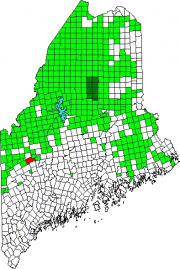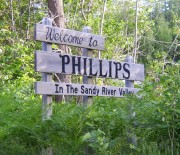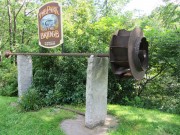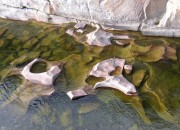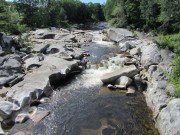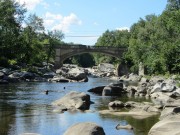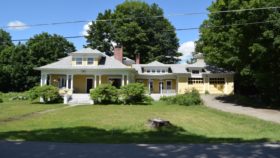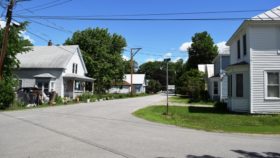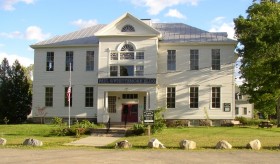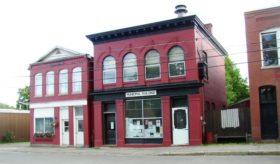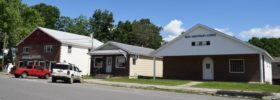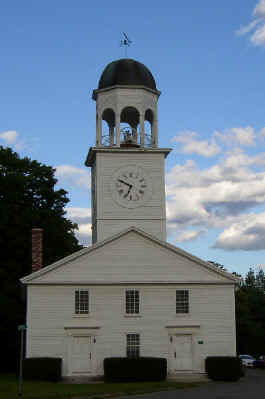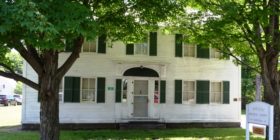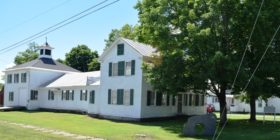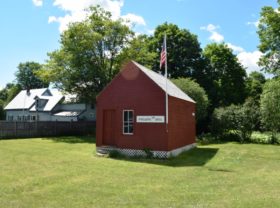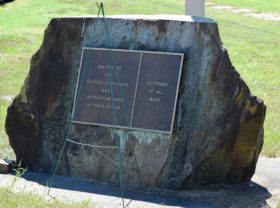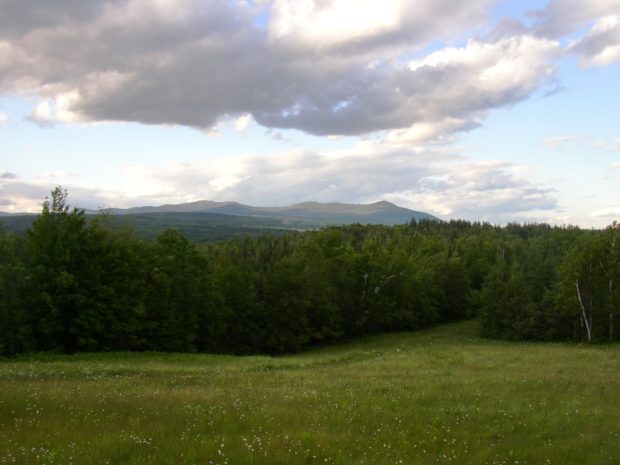
| Year | Population |
|---|---|
| 1970 | 979 |
| 1980 | 1,092 |
| 1990 | 1,148 |
| 2000 | 990 |
| 2010 | 1,028 |
| Geographic Data | |
|---|---|
| N. Latitude | 44:50:25 |
| W. Longitude | 70:22:22 |
| Maine House | District 112 |
| Maine Senate | District 17 |
| Congress | District 2 |
| Area sq. mi. | (total) 51.1 |
| Area sq. mi. | (land) 50.9 |
| Population/sq.mi. | (land) 20.2 |
County: Franklin
Total=land+water; Land=land only |
|
[FILL-ihps] is a town in Franklin County, settled in 1791 and, with about fifty families, incorporated on February 25, 1812 from Curvo Plantation.
Located 15 miles northwest of the county seat of Farmington, it is marked by a long winding stretch of the Sandy River and views of Maine’s western mountains.
The Sandy River-Rangeley Lakes Railroad, which transported people and forest products to and from the north woods, was once headquartered in the town.
As the Sandy River passes through the village, the river bed appears as frozen sand, almost bone-like in its strange shapes.
A canoe trip from here to Farmington begins well below the bridge offering spectacular views of boulders, rock-strewn shores, and high banks sheltering cliff swallows. Photos below are of Phillips Falls.
In the late 19th century the river powered a sawmill, grist mill, and a carding mill. Manufacturing activity centered on clothing, furniture, horse carriages and harnesses, and lumber.
In 1854, outdoors woman, columnist, and promoter of outdoor sports in Maine, Cornelia “Fly Rod” Crosby was born in the town. Yale University law graduate and U.S. Representative Carroll Beedy was born in Phillips in 1880. Three years later, in 1883, first woman speaker of a House of Representatives in the U.S., Minnie D. Davenport, was born here. She became speaker of the North Dakota House of Representatives in 1933.
The cultural amenities of the late 19th century, according to George Varney, included “A printing press . . . and the energetic, newsy and spicy ‘Phillips Phonograph’ . . . . Another literary institution of private ownership is a circulating library of about 400 volumes.”
The main village is located on the Sandy River at the junction of Maine Routes 4, 142 and 149. Near the village the Sandy River and Rangeley Lakes Railroad museum offers train rides and a walking tour of its buildings and restored railroad cars. The Mill Street neighborhood is a collection of modest houses in the village.
“Bear Hill” is a small, rural village area northwest of the main village.
Form of Government: Town Meeting-Select Board-Manager.
Additional resources
Davenport, Winona R. Phillips, Through My Eyes. Phillips? Me. W.R. Davenport. 1988.
*Maine. Historic Preservation Commission. Augusta, Me. Text and photos from National Register of Historic Places: http://pdfhost.focus.nps.gov/docs/nrhp/text/xxxxxxxx.PDF and http://pdfhost.focus.nps.gov/docs/nrhp/photos/xxxxxxxx.PDF
Pease, Albert. Sketches of History of Phillips, Maine. Maine? A. Pease. 1869.
Phillips: 175 years, 1812-1987. Phillips, Me. Phillips Historical Society. 1987.
Toothaker family. Family Papers, 1908-1947. Special Collections, Fogler Library, University of Maine. Orono.
Varney, George J. A Gazetteer of the State of Maine. 1886. pp. 443-444.
Whitney, Wendell. History of Phillips. Phillips, Me. Phillips Historical Society. 1933.
National Register of Historic Places – Listings
Maine Woods Office
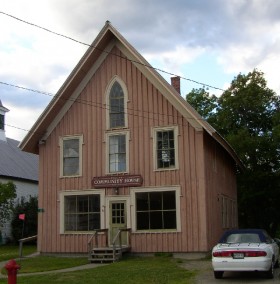 [Main Street] The “Maine Woods” office is significant not only as a rare architectural example but also because of its use as an important publishing office and its role in the social life of the community. It was built in 1848 by Moses Sherburne, a prominent lawyer and business man in the area. It is architecturally important as a rare example of a wooden Gothic Revival commercial building in Maine.
[Main Street] The “Maine Woods” office is significant not only as a rare architectural example but also because of its use as an important publishing office and its role in the social life of the community. It was built in 1848 by Moses Sherburne, a prominent lawyer and business man in the area. It is architecturally important as a rare example of a wooden Gothic Revival commercial building in Maine.
The building’s role in the community as a social institution started in 1851 when the upper floor became the first Masonic Hall in Phillips. It functioned in this manner until 1902 when a new Mason’s Hall was built. The most significant use of this building began in 1878 when the first floor served as the printing office for the Phillips Phonograph and the Maine Woods newspapers. The Maine Woods actually achieved an international reputation since it carried the latest news about hunting and fishing in Maine to thousands of sportsmen all over the world. In 1918 the Congregational Church purchased the building for use as a social center.*
Phillips High School
Phillips High School is a large, two story, wood frame building located in the town of Phillips. It was designed by George M. Coombs and built in 1894 as the second High School in town and later served as the Junior High School after several towns combined to build a new consolidated high school. The building reflects the type, period and method of construction for a high school of comparable age in northern Maine. It also reflects the broad historical patterns of educational philosophy and practice in its design, continued use and alterations. High School classes ended in the building in 1969 but the following year the building was repurposed as the Junior High School. That use ended in 1987. The building is currently the Phillips Public Library. See photo above left [click on any image to enlarge and clarify]
[Main and Pleasant Streets] The 1835 Union Church is the oldest of two historic religious buildings in the small village of Phillips. It is visually distinct by virtue of its tall tower and its location near the commercial district. The Union Church was built by the members of three Phillips religious denominations: the Universalists, the Free Will Baptists and the Congregationalists.
Of the three, the Baptists had the longest history in Phillips, beginning with the founding meeting in 1794. However, the Baptists who assumed a one-half interest in the new building are believed to have reemerged during the 1820s after the holding of regular meetings had lapsed some years earlier. The Universalist congregation, which had come together as a formal religious body about 1829, appears to have been the smallest of the three groups, having assumed only a one-sixth interest in the 1835 building. Finally, the Congregationalists, who first met on October 9, 1822, shared the remaining interest in the church. On September 10, 1835, the members of the three denominations dedicated their new building. Shared ownership of the church continued until 1931 when the Congregationalists acquired full interest and changed its name to the Phillips Congregational Church.
The Union Church is among the most significant buildings in Phillips and certainly its most prominent landmark. The tall tower provides a significant contrast to the church’s one and two-story residential neighbors, as well as to the nearby block of commercial buildings. These architectural features clearly distinguish the Union Church from the Gothic Revival style Methodist Church that was built in 1867. Of particular note is the open belfry that crowns the tower. Removed in 1939 because of its deteriorated condition, it was restored in 1982 from plans drawn by architect Christopher Glass of Camden.*
Captain Joel Whitney House
Captain Joel Whitney emigrated to Phillips with his parents and siblings between 1806 and 1815. In 1818 he was the town postmaster when he also purchased a 160 acre parcel. Over the next twenty years he built, bought and or sold several stores or offices near what is now the junction of Main and Pleasant streets, in the heart of Phillips. Whitney also built a sawmill on the Sandy River, owned extensive farmland, and a potash factory and participated in a large number of land purchases.
In the 1830s Whitney donated land for the construction of the Union Church, helped finance the building and donated the bell. The house that Whitney had built by local carpenter Jesse Ladd prior to 1829 is one of the oldest structures in the village. As a Captain of the local militia, town clerk, postmaster, farmer, trader and developer, Captain Whitney was described as a “somewhat remarkable man” by the historian Albert Pease in 1879.
He contracted with local carpenter Jesse Ladd to build him a house on Pleasant Street, near his stores and the mill. Whitney house served as a tavern, stage stop, and boarding house for the men building the Union Church, it was also Whitney’s residence for several years.
Jesse Ladd and his family lived a short distance away on another piece of land that Whitney later sold to Ladd in 1836. Since Whitney funded the construction of the school house and church during the 1830s, it is possible that Ladd was involved in these enterprises as well. The Whitney house is the only example of a two-story, single pile Federal house in Phillips, and while there are other mid-19th century capes scattered throughout the town, they are not as intricately executed as the Whitney house or the other Ladd built structures. The Whitney House, now home to the Phillips Historical Society, reflects in its location, style and details a lasting impression of the effect of both Whitney and Ladd to the growth and development of early Phillips.*


